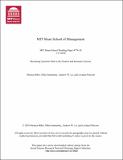| dc.description.abstract | A significant contributing factor to the Financial Crisis of 2007–2009 was the apparent interconnectedness
among hedge funds, banks, brokers, and insurance companies, which amplified
shocks into systemic events. In this paper, we propose five measures of systemic risk based
on statistical relations among the market returns of these four types of financial institutions.
Using correlations, cross-autocorrelations, principal components analysis, regime-switching
models, and Granger causality tests, we find that all four sectors have become highly interrelated
and less liquid over the past decade, increasing the level of systemic risk in the
finance and insurance industries. These measures can also identify and quantify financial
crisis periods. Our results suggest that while hedge funds can provide early indications of
market dislocation, their contributions to systemic risk may not be as significant as those
of banks, insurance companies, and brokers who take on risks more appropriate for hedge
funds. | en_US |
